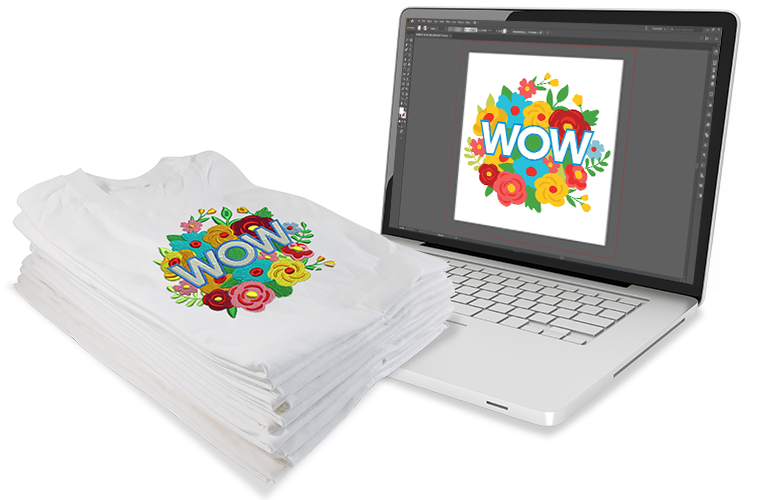Simplifying the Art of Needlework Digitizing: Step-by-Step Overview
As technology proceeds to breakthrough, the digitization procedure has become a lot more available, allowing fanatics to bring their detailed designs to life with ease. In this overview, we will unwind the intricacies of embroidery digitizing, breaking down each action methodically to simplify the process and encourage both novices and experienced embroiderers alike.
Recognizing Embroidery Digitizing Software
Needlework digitizing software program offers as a critical device for changing elaborate styles into electronic formats compatible with embroidery makers, helping with specific sewing and customization. This customized software program permits users to import different photo documents formats, such as JPG or PNG, and transform them into needlework machine-readable formats like DST, EXP, or PES - Digitizing for Embroidery. By using attributes like stitch editing and enhancing, padding alternatives, and thread color choice, digitizing software application makes it possible for individuals to control every facet of the style procedure
In addition, progressed needlework digitizing software offers tools for producing intricate layouts, adjusting stitch thickness, and including elaborate details. Customers can also sneak peek the layout before sewing it out, making certain precision and decreasing mistakes. Furthermore, lots of software program programs give automatic functions that assist enhance the digitizing procedure, conserving effort and time.
Comprehending the capabilities of needlework digitizing software is vital for accomplishing high-quality lead to needlework tasks. By grasping this device, embroidery enthusiasts and professionals can unleash their imagination and bring complex designs to life with precision and efficiency.

Choosing the Right Design Documents
After familiarizing yourself with the capabilities of needlework digitizing software application, the following essential step in the procedure is selecting the ideal style apply for your task. Digitizing for Embroidery. When picking a style apply for embroidery digitizing, it's necessary to consider the complexity of the layout, the dimension of the end product, and the type of fabric you will be collaborating with
For complex styles with great information, a high-resolution photo or vector documents is recommended to guarantee that the needlework device can properly reproduce the style. In addition, the size of the end product plays a significant function in picking the best layout data. Larger designs might need greater resolution data to maintain clearness and sharpness.
Additionally, the kind of fabric you will be stitching on affects the option of layout data. Different fabrics might call for modifications in the layout data to ensure that the stitches are effectively straightened and the style looks like meant. By meticulously picking the ideal design documents based on these factors, you can set on your own up for a successful needlework digitizing process.
Digitizing Devices and Strategies
Using specialized software application and accuracy strategies, digitizing tools are important in transforming intricate styles into embroidery-ready files. Needlework digitizing software, such as Wilcom, Hatch, or Embrilliance, gives the required platform to transform art work right into stitch information. These programs provide functions like stitch editing and enhancing, padding alternatives, and lettering tools to ensure the style translates perfectly onto material.
Among the key strategies in digitizing is creating a clear path for the needlework equipment to adhere to. This entails digitizing each aspect of the style with precision, determining stitch kinds, densities, and directions. By utilizing tools like digitizing tablet computers or software-specific plugins, embroiderers can achieve a high level of accuracy in their digitized designs.
In addition, grasping the art of underlay stitching is essential for creating quality embroidery. Underlay stitching supports the fabric have a peek at this website and develops a foundation for the layout, making certain that the end product is both visually appealing and long-lasting. By comprehending these digitizing tools and strategies, embroiderers can boost their craft and bring intricate styles to life with accuracy and performance.
Personalizing Stitch Kinds and Instructions
Having actually established a structure in digitizing tools and techniques, a vital aspect in advancing needlework workmanship hinges on personalizing stitch kinds and instructions with accuracy and objective. The choice of stitch types can substantially impact the general appearance and texture of the stitched design. Satin stitches, known for their smooth and glossy surface, job well for creating borders and message. On the other hand, fill stitches are excellent for covering larger areas successfully. By tactically incorporating these stitch kinds, embroiderers can accomplish deepness and measurement in their styles.
In addition, look at this website the direction of stitches plays a critical role in boosting the aesthetic appeal of the last embroidery. By exploring with different stitch angles and patterns, embroiderers can bring their layouts to life with amazing information and intricacy.
Testing and Refining Your Digitized Design
To make certain the accuracy and high quality of your digitized design, complete screening and refinement are crucial actions in the needlework digitizing process. As soon as you have finished the digitization of your design, it is essential to evaluate it before waging the actual embroidery. Examining allows you to recognize any potential issues such as thread breaks, sew thickness troubles, or design distortions that might influence the result.

After screening, it is essential to fine-tune your digitized layout based upon the responses from the test sew-out. This might entail tweaking stitch setups, readjusting densities, or making adjustments to the total style to accomplish the preferred outcome. By iterating through screening and improvement, you can fine-tune your digitized layout to excellence prior to progressing with the actual needlework process.
Final Thought
In verdict, grasping the art of needlework digitizing needs a thorough understanding of the software program, choosing the best style file, using digitizing devices and strategies, customizing stitch kinds and directions, and screening and fine-tuning the digitized design. By adhering to these steps, embroiderers can simplify the digitizing process and develop top quality stitched styles with precision and efficiency.
Comments on “Professional Digitizing for Embroidery: High-Quality Designs”